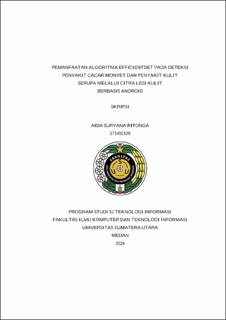Pemanfaatan Algoritma EfficientDet pada Deteksi Penyakit Cacar Monyet dan Penyakit Kulit Serupa melalui Citra Lesi Kulit Berbasis Android
Utilization of EfficientDet Algorithm for Detecting Monkeypox and Similar Skin Diseases through Android Based Skin Lesion Images

Date
2024Author
Ritonga, Aida Suryana
Advisor(s)
Huzaifah, Ade Sarah
Lubis, Fahrurrozi
Metadata
Show full item recordAbstract
Monkeypox is a zoonotic infectious disease caused by the monkeypox virus, transmitted from animals such as rodents and monkeys to humans, as well as between humans through direct contact or contaminated objects. Symptoms include fever, headache, muscle aches, fatigue, and skin rashes resembling smallpox. Although several studies on monkeypox have been conducted, previous research has only classified monkeypox rather than focusing solely on it. This study utilizes the EfficientDet algorithm based on Android to detect monkeypox by comparing images of human skin lesions exposed to other similar skin diseases, such as chickenpox, Hand Foot Mouth Disease (HFMD), and normal skin. Deep learning is a suitable method for image detection with relatively large datasets. The chosen algorithm, EfficientDet, is known for its high accuracy in detecting objects in images or videos. The data used includes images of skin lesions caused by monkeypox, chickenpox, HFMD, and normal skin, sourced from open-source platforms like Kaggle and Dermnet, totaling 4,856 images. These images are labeled as Monkeypox, Chickenpox, HFMD, and Normal. The dataset is divided into three parts: 3,714 for training, 1,062 for validation, and 80 for testing. This study achieved a satisfactory level of accuracy with the following metrics: an accuracy rate of 96%, a recall value of 0.96, a precision value of 0.96, with the best model being EfficientDet-d1.
Collections
- Undergraduate Theses [767]
